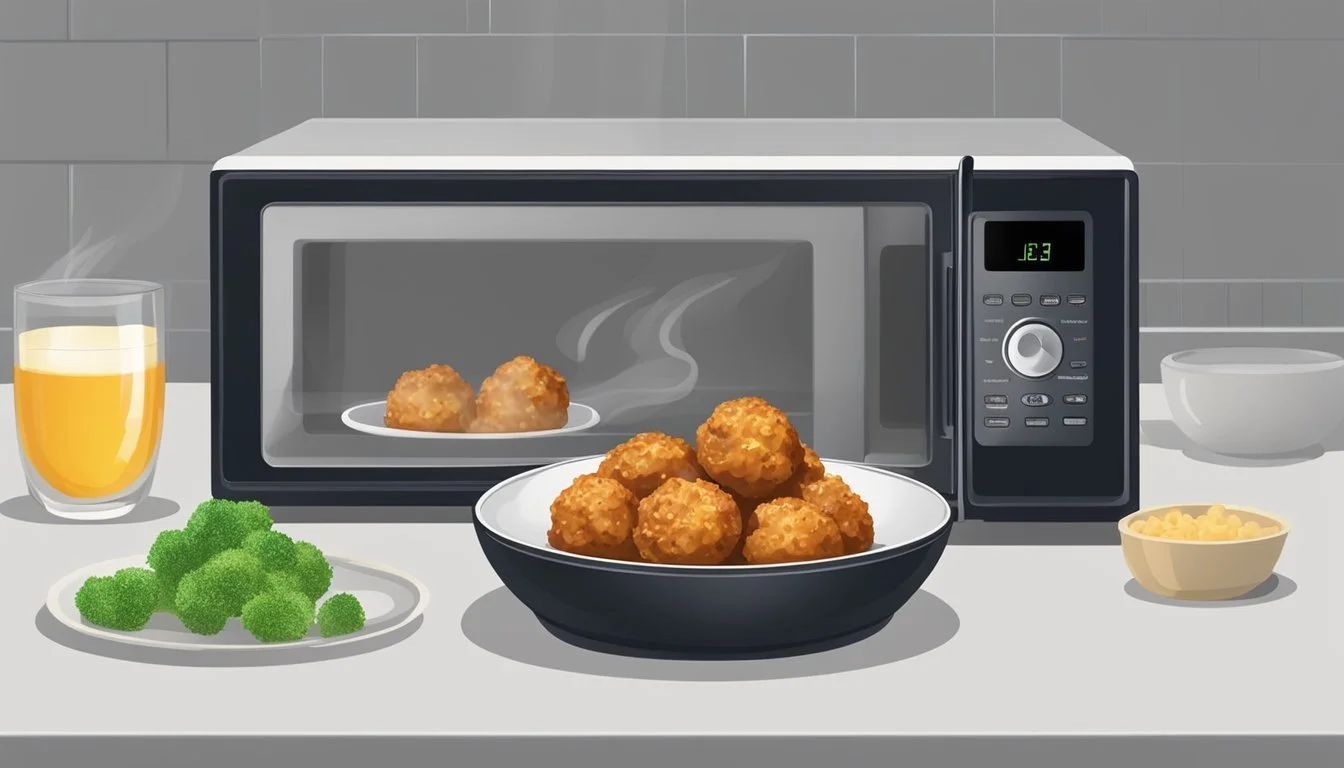How to Reheat Chicken Meatballs for Perfect Taste and Texture
Chicken meatballs are a beloved comfort food for many, thanks to their versatility and ease of preparation. Whether enjoyed on their own or paired with a savory sauce, they often make a satisfying meal. But what if you have leftovers and want to enjoy them just as much the second time around?
Reheating chicken meatballs properly can make all the difference in maintaining their moist, delicious texture. There are several methods to achieve this—microwave, stovetop, or air fryer—all ensuring your meatballs retain their flavorful goodness. Each technique has its benefits, and the best choice often depends on the tools you have at hand and your taste preferences.
From evenly reheated meatballs in the microwave to a crispy finish in the air fryer, this guide explores the best methods to reheat chicken meatballs. Whether you're in a hurry or looking for that perfect re-crisp, these tips ensure your meatballs will never fall short of your expectations.
Understanding Meatballs
Meatballs are a versatile dish enjoyed in various cuisines. They can be made from different types of meat and include various ingredients that add flavor and texture. Proper storage is essential to maintain their freshness and taste.
Varieties of Meatballs
Meatballs come in many forms depending on the type of meat used. Common types include beef, pork, turkey, and lamb.
Beef meatballs are popular in Italian and American cuisine, often served with tomato sauce and pasta.
Turkey meatballs are a leaner alternative, suitable for those looking to reduce fat intake.
Pork meatballs are typically juicier and can be found in various Asian dishes.
Lamb meatballs have a rich, unique flavor and are often seasoned with spices like cumin and coriander.
Each type of meatball offers a different taste and texture, making them adaptable to numerous recipes.
Meatball Ingredients
A fundamental meatball recipe consists of a combination of ground meat, a binding agent, seasoning, and sometimes additional flavor enhancers.
Meat: Ground beef, pork, turkey, or lamb.
Binder: Eggs and breadcrumbs are commonly used to hold the mixture together.
Seasonings: Salt, pepper, garlic, and onion.
Herbs: Fresh parsley or dried herbs like oregano and basil.
These ingredients are mixed and then shaped into balls. Different combinations can result in various flavors and textures. The use of fresh ingredients like garlic and onion contributes significantly to the overall taste.
Storing Meatballs
To maintain the quality of meatballs, proper storage is essential. Cooked meatballs should be cooled to room temperature before storing.
Refrigeration: Store meatballs in an airtight container for up to 3-4 days.
Freezing: For longer storage, place meatballs on a baking sheet to freeze individually before transferring them to freezer bags. This method prevents them from sticking together.
Reheating: When reheating, make sure meatballs are thoroughly heated to an internal temperature of at least 165°F (74°C) to ensure safety.
Correct storage practices help in preserving the flavor and texture of meatballs, making them convenient for later use.
Preparation for Reheating
Proper preparation ensures that reheating chicken meatballs is both safe and effective. Key steps include defrosting frozen meatballs and organizing your work area for reheating.
Defrosting
If your chicken meatballs are frozen, begin by defrosting them properly. Remove the meatballs from the freezer and transfer them to the refrigerator. This method, though slow, maintains the meatballs' texture and flavor. Allow about 24 hours for complete defrosting.
For faster defrosting, use the defrost setting on your microwave. Place the meatballs in a microwave-safe container and cover. Check and rotate the meatballs every few minutes to ensure even thawing.
Ensure all meatballs are defrosted to an internal temperature below 40°F before reheating to avoid bacterial growth.
Prepping Your Work Area
Before reheating, organize your work area. Gather necessary tools and ingredients: a microwave-safe bowl, water or sauce, plastic wrap or lids, an oven-safe dish if using an oven, and any desired spices or seasonings.
Sanitize surfaces to avoid contamination. Position your equipment for easy access, ensuring you have sufficient space to work. Arrange utensils like tongs and spatulas for safe handling.
Prepare your container by lightly greasing it if using an oven to prevent sticking. In the microwave, add a bit of water to the bowl to preserve moisture. Cover the meatballs with pierced plastic wrap or a microwave-safe lid.
Ensure you follow reheating instructions precisely to maintain the best texture and flavor of the chicken meatballs.
Reheating Meatballs in the Oven
Using the oven to reheat meatballs ensures even heating and helps retain moisture. This method is ideal for maintaining the texture and flavor of chicken meatballs, whether they are plain or sauced.
Oven Safety and Preheating
Begin by preheating your oven to 350°F (175°C). This temperature is optimal for reheating meatballs without overcooking them.
Place the oven rack in the middle position to promote even heating. Always use oven mitts and exercise caution when handling hot surfaces and dishes.
For food safety, ensure that reheated meatballs reach an internal temperature of 165°F (74°C). Use a kitchen thermometer to verify.
Oven Reheating Steps
Start by lining a baking sheet with parchment paper or lightly greasing it to prevent sticking. Arrange the meatballs in a single layer on the baking sheet, leaving space between each one for even heating.
Cover the meatballs with aluminum foil to preserve moisture. Place the baking sheet in the preheated oven and heat for 10-15 minutes.
If reheating frozen meatballs, allow for an extra 5-10 minutes of cooking time. To ensure they are properly heated, check the internal temperature with a thermometer.
Optional: Remove the foil for the last 2 minutes of heating if a crispy exterior is desired. Warm any accompanying sauce separately on the stovetop to avoid sogginess. Adjust reheating time based on the meatball quantity and initial temperature.
Reheating on the Stovetop
Reheating chicken meatballs on the stovetop allows for even heating and optimal texture retention. This method also lets you incorporate sauce directly, ensuring deliciously warm meatballs.
Stovetop Method Overview
To start, use a non-stick pan or skillet. Set the stove to medium heat and add a small amount of oil to the pan to prevent sticking. Place the chicken meatballs into the pan, ensuring they are evenly spaced.
Cover the pan with a lid to trap the heat. Allow the meatballs to heat through for about 10-12 minutes, turning them occasionally to ensure even cooking. If the meatballs start to dry out, sprinkle in a little hot water to maintain moisture.
Cooking with Sauce
Reheating chicken meatballs with sauce on the stovetop enhances flavor and prevents drying out. Begin by setting the stove to medium heat. Use a pot or skillet and pour in the sauce you plan to use.
Add the meatballs directly into the sauce. Stir occasionally to coat them well and ensure even heating. Keep the pot covered with a lid to retain moisture and heat.
Cook for about 10-12 minutes, occasionally stirring to prevent the sauce from sticking or burning. If the sauce reduces too much, add a few teaspoons of water as needed. Make sure the meatballs are heated thoroughly before serving.
Reheating Meatballs in a Microwave
Reheating meatballs in a microwave is quick and efficient, ensuring they are evenly warmed through without drying out. Following these steps prevents the meatballs from becoming rubbery or soggy.
Microwave Reheating Steps
1. Prepare the Meatballs: Place the meatballs in a microwave-safe dish. Make sure they are evenly spaced to allow even heating. If reheating frozen meatballs, thaw them slightly first.
2. Add Moisture: Sprinkle a small amount of water or broth over the meatballs. This prevents them from drying out during the reheating process.
3. Cover the Dish: Use a microwave-safe cover or plastic wrap with small holes poked in it. This traps steam, keeping the meatballs moist.
4. Set the Power Level: Microwave on medium power (about 50%) to ensure even reheating without overcooking. This is essential for maintaining the texture of the meatballs.
5. Microwave in Intervals: Heat the meatballs in 30-second intervals, checking after each interval. Stir or flip them to ensure even heating. This usually takes about 1-2 minutes in total, depending on the number and size of the meatballs.
6. Check Temperature: Ensure that the internal temperature of the meatballs reaches at least 165°F (74°C) to ensure they are thoroughly reheated.
7. Let Rest: After reheating, let the meatballs rest for a minute before serving. This allows the heat to distribute evenly throughout the meatballs.
Using an Air Fryer or Instant Pot
Reheating chicken meatballs can be optimized using either an air fryer or an Instant Pot. Each method offers distinct advantages, such as achieving a crispy exterior with the air fryer or retaining moisture with pressure cooking.
Air Fryer Reheating
Preheat the air fryer to 350-400 degrees Fahrenheit for 5 minutes. Place the chicken meatballs in the air fryer basket, ensuring they are spaced out to allow for even cooking. Heat them for approximately 7-10 minutes.
If you prefer a crispy finish, extend the cooking time by an additional 2 minutes. Use a meat thermometer to confirm the internal temperature has reached 165°F. Avoid leaving them in the basket after turning off the air fryer to prevent them from drying out.
Pressure Cooking in the Instant Pot
Add 1/2 to 1 cup of liquid—such as water, broth, or sauce—into the Instant Pot. This liquid creates steam and pressure, ensuring the chicken meatballs heat evenly. Arrange the meatballs in a single layer at the bottom of the pot.
Set the Instant Pot to high pressure and cook for 5-7 minutes. Use the quick release method to safely reduce pressure. Remove the meatballs immediately to retain moisture and avoid overcooking.
Additional Tips and Techniques
To maintain juicy and tender chicken meatballs, consider adding a splash of broth or water when reheating. This helps to prevent them from drying out.
For leftover meatballs, they can be transformed into a flavorful main dish. Simply toss them with some marinara sauce and serve over pasta or in a sandwich.
Homemade meatballs can be reheated in a baking dish covered with foil. This method retains their tenderness while ensuring even heating.
To reheat meatballs with gravy, place them in a pot and cover with a lid. Heat on low until warmed through, stirring occasionally. This technique enhances their flavor and keeps them moist.
If preparing for a party or make ahead meals, reheat the meatballs and keep them in a warm serving dish. This makes them a convenient appetizer for any gathering.
Using a microwave to reheat meatballs? Cover the ingredient evenly, sprinkle with water, and use short intervals. This method can be quick but needs careful monitoring.
For a dinner option, placing meatballs in a preheated oven at 300°F ensures they're evenly heated without drying. This suits both plain and sauced meatballs.
Chicken meatballs can be added to a variety of dishes. They pair well with marinara sauce for a rich, flavorful meal or can be served on their own as a nutritious main dish.
Meatballs can also be reheated using an Instant Pot. Place them with sauce, use high pressure for a few minutes, and release the pressure carefully. This retains their moisture and flavor effectively.





